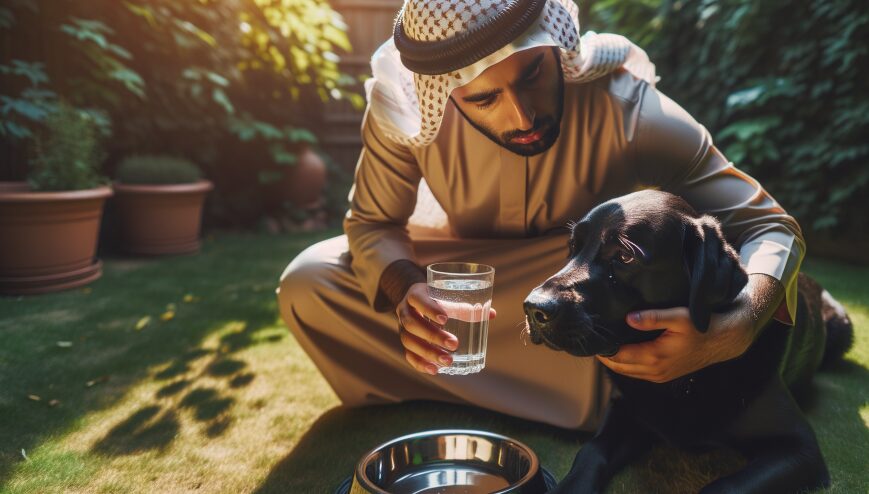AI-assisted
Last updated on July 9, 2025
As a dog owner, you know a mix of good food is vital. Yet, have you thought about how much water your dogs needs? Water is just as key. For water dogs, it fuels their gut, joints, and cells. Moreover, it helps prevent kidney damage and keeps electrolytes in balance.
So, how do water dogs stay fit? First, give fresh water in a sturdy bowl. Next, use a filtered bowl or a pet water fountain for clean, running water. Also, note your dog’s size and age to track daily water needs. If you spot dry gums or sunken eyes, your dog may be dehydrated. Then, add wet food or toss in a few ice cubes. Finally, place a cool fountain in your home to encourage water dogs to drink more.
In short, good hydration keeps dogs healthy and can help them live longer. Therefore, keep an eye on water for dogs to keep your furry friend strong and happy.
The Importance of Water in Dog Nutrition

Water is essential for your dog’s health and nutrition. Moreover, proper drinking helps keep fluid levels balanced. For example, water supports digestion, circulation, and joint health. You might wonder: why is water so vital for dogs? Simply put, it affects every cell in their body.
First, make sure your dog always has a clean water bowl. Otherwise, dehydration can harm their health and nutrition. Therefore, dog owners should focus on boosting hydration. You may also ask: how much water should a dog drink? Generally, aim for one ounce of water per pound of body weight each day. Finally, knowing how water affects metabolism guides pet parents in proper care.
Proper Hydration Requirements
Proper hydration is crucial for dogs. Dog owners and pet parents need to know water requirements and dog hydration. Strong canine hydration and clear hydration guidelines help keep moisture intake steady. Tracking water intake, liquid consumption, fluid balance, and moisture intake ensures healthy hydration levels. Why is hydration important for dogs? How much water does a dog need?
| Dog Weight | Daily Water Intake |
|---|---|
| 10 lbs (4.5 kg) | 1 – 1⅓ cups (240 – 320 mL) |
| 20 lbs (9 kg) | 2 – 2⅔ cups (480 – 640 mL) |
| 40 lbs (18 kg) | 4 – 5⅓ cups (960 – 1280 mL) |
| 60+ lbs (27+ kg) | 6 – 8+ cups (1440 – 1920+ mL) |
Dehydration signs like dry gums, sunken eyes, or lethargy warn of trouble. Pet hydration and clear moisture requirements can help maintain pet wellness and improve dog health. For long-term health, learn how much water should a small dog drink. Also explore the best ways to keep a dog hydrated. For dog water consumption and dog hydration tips, always refill the bowl during hot weather and after exercise.
Signs of Dehydration in Dogs
It’s vital for new dog owners and pet parents to know dog dehydration and dehydration signs. Good pet hydration supports dog health and prevents serious issues.
How to tell if my dog is dehydrated? What are dog dehydration symptoms? Answering these questions can help you act fast to prevent dog dehydration and identify dehydration early.
Watch for these red flags of fluid loss and water deficiency:
- Sunken eyes and dryness around the sockets.
- Sticky or dry gums and general thirst.
- Lethargy and refusal to move during exercise recovery.
- Heavy panting in summer heat.
Follow simple dog hydration tips to keep your pet safe. Offer fresh water often to avoid heat stroke or electrolyte imbalance. Regular checks of canine health signs will give you peace of mind.
Recognizing the Symptoms
First, dog owners must watch for dehydration signs in dogs. Why is my dog dehydrated? Dehydration and hydration go hand in hand, so spotting symptoms early is vital.
Next, perform simple checks to identify dryness. Gently pinch your dog’s skin at the scruff. If it stays tented, loss of skin elasticity shows dehydration.
Then, look for sunken eyes and a dry nose. These clear hydration symptoms point to water deficiency and low moisture intake.
Also, pay attention to behavior. Heavy panting, lethargy, or loss of appetite can signal fluid loss.
Finally, keep your furry friend cool in hot weather and after exercise. Regular pet care and canine health checks can help avoid serious issues.
By knowing how to tell if my dog is dehydrated and what signs my dog is dehydrated, pet parents can act fast and keep their companion healthy.
How to Prevent Dehydration
New dog owners and puppy parents must learn about dog hydration and dehydration prevention.
This guide offers clear pet hydration tips and explains hot weather hydration needs.
How much water should a dog drink?
Using best practices for dog hydration monitoring helps set routines.
Tracking water intake and moisture balance keeps dogs healthy.
To prevent dehydration, refill your clean water supply at least once daily.
A pet water fountain boosts fluid consumption and helps replenish fluids and moisturize your dog’s system.
Why is my dog dehydrated?
Simple habits support kidney health and skin elasticity.
Always monitor water intake and offer fresh water after exercise.
Here are steps to follow on how to keep my dog hydrated during summer:
| Action | Description | Frequency |
|---|---|---|
| Refill Water Bowl | Top up clean water supply to maintain ideal hydration. | Daily |
| Clean and Refresh Bowl | Wash the bowl and replace water for proper moisture balance in your dog’s bowl. | Daily |
| Check Hydration Signs | Look for signs of dog dehydration like sunken eyes or dry gums. | Weekly or as needed |
| Consult Your Veterinarian | Seek advice if you can’t correct dehydration or notice serious symptoms. | As needed |
By applying how to keep my dog hydrated during summer routines, puppy parents can secure good hydration for their pets.
Watch for signs of dog dehydration and act fast.
Good habits prevent dehydration and support dog health.
Dangers and Long-Term Effects of Dehydration
Dehydration dangers in dogs can be severe. Dehydration harms dog health. When a dog has fluid deficiency or moisture loss, vital organs struggle. It can lead to electrolyte imbalance and kidney failure. Poor fluid balance strains the kidneys. Over time, these dangers of dehydration in dogs show the long-term effects of dog dehydration.
What happens if my dog is dehydrated? Lack of water slows circulation and hurts digestion. It may cause poor blood flow and weak immune defenses. After exercise recovery or in hot weather, water is even more vital. Dogs that skip water face pet hydration issues. Poor fluid intake affects canine health.
Chronic dehydration may cause kidney damage and urinary infections. Over months, it adds stress on the kidneys and can end in kidney failure. These dehydration effects require early action to prevent dehydration and maintain hydration.
How to prevent dehydration in dogs? Offer fresh water often. Check their water bowl after walks and play. Keep water cool during hot weather and after exercise recovery. Good pet hydration helps avoid fluid deficiency and moisture loss.
Pet owners and dog parents must know dehydration dangers and dehydration effects. To maintain hydration and promote dog health, watch water intake daily. With care, you can protect your pup from long-term effects of dog dehydration.
Ensuring Your Dog Stays Hydrated
It’s vital for dog owners and pet parents to know dog hydration and follow easy hydration tips. How much water should a dog drink? Why is my dog dehydrated?
Continuous fresh water circulation in a canine water fountain helps maintain fluid intake and moisture balance. This hydration solution for pets makes water more appealing during hot weather and after outdoor activities.
To improve dog hydration, use these best hydration strategies for dogs:
- Offer cool water often.
- Add ice cubes or frozen treats.
- Clean the bowl daily to boost pet hydration.
Consider where to buy dog water fountain or a spill-proof bowl to help replenish fluids and moisturize your pup’s cells. Ensure proper canine water intake for every dog.
These actions support overall pet health and canine wellness. For how to keep your dog hydrated, stay vigilant, refill bowls, and enjoy a happier, healthier companion!
Frequently Asked Questions
Q1: How does water quality impact my dog’s health and nutrition? Clean water supports dog hydration and proper water intake. Pure water prevents toxins, helps moisture balance, and boosts nutrition. Using a high-grade filter and rotating fresh water maintains fluid consumption. Good water quality also protects kidney health and electrolyte balance and reduces urinary issues. For new puppy owners, learn about best water source for dogs and how does water quality impact my dog’s health to buy dog water filter features.
Q2: Do certain breeds or life stages require different water intake for optimal health? Yes, requirements vary. Active dog hydration needs rise during exercise and hot weather hydration in summer. Puppies need smaller volumes but frequent drinking, while seniors benefit from steady hydration and electrolyte support. How to improve dog hydration? Use these hydration tips: offer water fountains and add ice cubes to bowls. Knowing what water do dogs need? Aim for about 50 mL per kg of body weight daily.
Q3: Are specific health conditions that affect a dog’s ability to stay hydrated? Conditions like kidney disease, diabetes, and Cushing’s can hinder fluid retention. Watch for signs of canine dehydration such as sunken eyes or sticky gums. Also maintain water quality to avoid bacterial infections. Consult your vet for tailored hydration strategies to manage conditions and protect overall well-being.
Q4: How can I monitor my dog’s water intake to ensure they meet hydration needs? Track water intake by measuring daily bowl levels. Use apps or simple charts for dog daily water requirements and spot trends early. A spill-proof bowl helps keep records accurate. Rotate clean water often and check quality to uphold hydration success. You can also monitor dog water intake with a water-tracking feeder.
Q5: Are there supplements or specific dog foods that support proper hydration? Yes. Moisture-rich foods like wet food or broths improve fluid consumption. Electrolyte-enhanced water additives and hydration chews can boost moisture levels. These simple solutions help dogs maintain hydration during travel or hot days. For senior dog care, choose diets with higher water content and discuss supplementation with your vet.
Conclusion
Don’t skip dog hydration in your pet’s diet. Understanding water requirements helps new dog owners and puppy parents. Ask yourself: how much water does a dog need to thrive? Also consider how to keep my dog hydrated and why is hydration important for dogs.
Recognize hydration benefits like better energy and digestion and watch for signs of dehydration in dogs and dehydration signs. Offer clean water, buy dog water fountain, and monitor water intake to support kidney health and bloat prevention. You can also add ice cubes or flavored fluids to boost moisture balance and fluids intake. Track fluid intake to meet canine water needs. In hot weather and after outdoor activities, keep fresh water handy. These pet hydration tips make dog care simple and ensure happy, healthy pups.
“Further Reading”
American Kennel Club. How Much Water Should Your Dog Drink?
Veterinary Partner. Water Requirements, Dehydration, and IV Fluids in Dogs.
Journal of Animal Physiology and Animal Nutrition. Open Access Articles on Water Balance in Dogs.
American Veterinary Medical Association. Pet Hydration: Why Water Matters
The Spruce Pets. Vet-Approved Homemade Dog Food Recipes and Hydration Tips.



